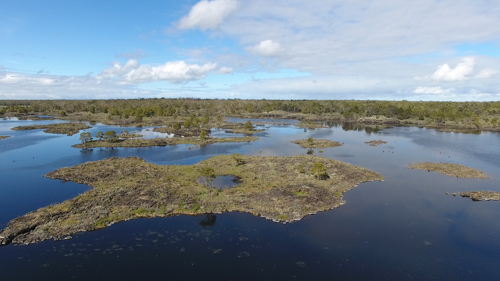The Budj Bim Cultural Landscape is a serial property comprised of three components; Budj Bim (northern) component, Kurtonitj (central) component and Tyrendarra (southern) component Each component contains extensive evidence of the Gunditjmara’s aquaculture system. The Gunditjmara have customary rights and obligations to their traditional Country and a continuing and evolving relationship with the Budj Bim Cultural Landscape. The Budj Bim Cultural Landscape incorporates significant components of an area that the Gunditjmara call Tungatt Mirring (Stone Country); an area centred on dramatic volcanoes and lava flows. The area encompasses Budj Bim volcano, the Budj Bim lava flow, extensive wetlands and lakes, including Tae Rak (Lake Condah), and Killara (Darlot Creek). Tungatt Mirring today is marked by rugged stony landscapes cloaked with Manna Gum woodland; interspersed with species-rich, wetland environments. The Budj Bim volcano is the source of the Budj Bim lava flow. More than 30,000 years ago, lava spewed across a distance of over 50 kilometres west and south towards the sea, dramatically altering the local waterways and wetlands. The lava flow provided the environment necessary for the Gunditjmara to develop an extensive and complex aquaculture network. The quantities of food produced allowed for and supported semi-permanent settlements. The success of the aquaculture system was such that excess kooyang (short-finned eel) supported large-scale ceremonial events and trade with neighbouring groups.
Budj Bim Cultural Landscape

Government evidence of impact of climate change:
-
Australian Government, Budj Bim Cultural Landscape World Heritage Nomination
These factors together with the continuing Gunditjmara custodianship; are likely to give the nominated property’s eco cultural systems a high level of resilience to climate change and associated long term environmental pressures.
CLIMATE CHANGE Climate change is projected to impact the region in which Budj Bim Cultural Landscape is situated.
Dry Forests and Woodland ecosystems common across the Budj Bim (northern) component of the nominated property; are subject to projections of a hotter and drier climate with increased wildfire risks.
A warming climate is predicted to exacerbate many of the existing threats and has implications for the abundance and distribution of some plant and animal species.
Parks Victoria 2010 3; 46 2015 KOOYANG POPULATION Inland Waters and Wetland ecosystems are considered vulnerable to climate change with increased stress on waterways already under pressure from rising salinity levels and decreasing water quality.
Due to the Gunditjmara’s restoration of Tae Rak (Lake Condah); its relative isolation; the low level of population and absence of major development together with continuing Gunditjmara custodianship; the Budj Bim Cultural Landscape’s hydrological and ecological systems are likely to have a higher level of natural resilience to climate change than can be expected of coastal and alpine environments that are already suffering multiple environmental pressures.
The potential impact of climate change; water quality and over fishing on kooyang is high though the current level of risk is low.
Victorian Aboriginal Heritage Register (Aboriginal Victoria; Melbourne) 5 years Climate change Increase in research on climate change impacts and appropriate adaptation measures.
-
Parks Victoria, Ngootyoong Gunditj Ngootyoong Mara SouthWest Management Plan May 2015
Works and services with partners Goal The impacts of climate change on ecosystems and species are minimised across the planning area.
Works and services with partners Identify and protect areas that can act as climate change refugia for threatened and endangered species.
Dry Forest and Woodlands are subject to climate change projections of a hotter and drier climate with increased fire.
Inland Waters and Wetlands are considered highly vulnerable to climate change with increased stress on rivers already under pressure from salinity; over allocation of water for agricultural and other uses and declining water quality.
Key threats to heathland include inappropriate fire regimes; habitat loss and modification; the introduction and spread of invasive plants; predation of native fauna by introduced species; grazing by introduced species; the impacts of climate change and the introduction or spread of the soil pathogen Phytophthora.
Coastal environments are predicted to be impacted by climate change with more frequent storms; resulting in potential inundation and coastline erosion.
In addition; coastal ecosystems and species are also subject to the climate change related threats such as hotter; drier conditions and increased fire.Key threats to water column assets such as seabirds and whales are oil spills and climate change.
Climate change poses a serious threat with the marine environment predicted to be impacted by higher sea temperatures; changing sea currents and acidification of the ocean.
Goal The highly productive dense stands of habitat forming algae that provide cover and food for a diverse assemblage of fish and invertebrates in the subtidal reef ecosystem are maintained; and the impacts from illegal activities and climate change are reduced and the spread and establishment of marine pathogens and pests are prevented through effective partnerships (focus area is Discovery Bay Marine NP).
Brittle Star Discovery Bay Marine National Park Goal A well connected and highly productive water column ecosystem that supports planktonic health and nutrient cycles to provide the trophic base for higher order species including cetaceans; pinnipeds; elasmobranchs and other pelagic fish; and seabirds is maintained; impacts from oil spills are prevented and impacts from climate change are reduced through effective response and partnership arrangements; (focus area is Discovery Bay Marine NP).
Drought has further reduced stream flows and climate change could in some cases push the situation across critical thresholds.
River and wetland rehabilitation are important for increasing the resilience of freshwater systems to the impacts of climate change.
Climate change may damage significant sites through coastal flooding; erosion or bushfire.
Inappropriate fire regimes; either through bushfire or planned burning; may lead to a loss of biodiversity and a decline in ecosystem health; changes to vegetation composition and structure and loss or damage to cultural values and social and economic opportunities.
Heathland Natural Ecosystem requires fire at intervals of between five and thirty years.
Works with the community Ensure the impacts from large scale events; such as bushfire and flood; are mitigated as soon as practicable.


